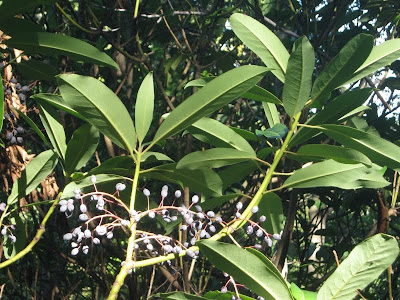A family of 15 evergreen shrubs or trees native to Asia that can be grown for their very attractive foliage. They prefer partial shade and a site protected from excessive wind. Slightly acid, deep, moist well drained soil is preferred as it a layer of protective mulch. They are NOT eaten by deer.
Generally pest and disease free and reproduction is easy from stratified seed or also softwood cuttings or semi ripe cuttings in summer.
Daphniphyllum calycinum
An evergreen shrub, reaching up to 13 x 13 feet, that is native to southern China, Japan and Vietnam.
The leaves, up to 6.5 x 3.5 inches, are bright green above, even brighter green beneath.
Bloomy black fruits are borne on female plants that are pollinated.
Hardy zones 7b to 9 in full sun to partial shade on moist, well drained soil. It is very heat and humidity tolerant and thrives in the southeastern U.S.
Daphniphyllum glaucescens
Native from central & southern China, south into Indonesia.
It is a very beautiful, vigorous, evergreen tree reaching up to 50 x 20 feet; it can reach up to 20 feet in 20 years and the largest on record is 100 feet.
The luxuriant, blue-green, oval leaves are up to 7 x 2 inches in size.
The blackish-purple fruits persist through the winter.
An understory plant in the wild; it prefers moist shade when young however eventually may emerge into the tree tops into full sun.
Hardy north to zone 7 to 9. While rare; this extremely beautiful plant has much potential in both the Pacific Northwest and the southeast U.S.
* photos taken on October 17 2010 @ U.S. National Arboretum, D.C.


subsp. Oldhamii
New foliage extremely attractive bright orange to deep to purple red fading to green in summer.
Daphniphyllum humile
A forest understory shrub native to Korea & Japan; it is slow growing reaching up to 15 inches in 2 years and eventually to 4 x 6 feet. The largest on record is 10 x 15 feet. Rarely seen in North America, it deserves to be much more widely used.
The alternatively-spaced, evergreen foliage is dense and narrowly-elliptic in shape. The glossy leaves, up to 6 x 2 inches, are bright green at first turning to deep green. The flowers are small and not highly visible.
An excellent, dense, tall groundcover for shady sites.
Hardy zones 6 to 10 in partial to full shade.
Daphniphyllum macropodium
The Courtesy Leaf is a very beautiful, tropical looking, vigorous, dense large shrub or tree native to China, Korea and Japan. Some records include: fastest growth rate - 2 feet; largest on record - 50 x 50 feet with a trunk diameter of up to 3.3 feet.
The large, thick, leathery, oval leaves grow up to 9 x 4 inches and look like that of the Catawba Rhododendron. The waxy leaves are reddish at first, turning to very deep green above, dull gray below. They are carried on showy, red leaf stalks.
The tiny light green flowers borne during spring are barely noticable.
The fruit is blue-black up to 0.5 inches in size and can persist thru the winter.
The stems are reddish-purple.
They make both a great specimum plant and screen, and tolerate salty ocean breezes well. It grows best in moist, well drained, acid soil and likes shelter and part shade though tolerant of full sun. It is not bothered by pests and diseases. Hardy zones 6 to 9; heat tolerant and grows very well in the Mid Atlantic and southeastern U.S. Surprisingly cold tolerant for a plant of such tropical appearance. The Courtesy Leaf is very easy to grow.
* pics taken Feb 2009 @ U.S. National Arboretum





* photo taken on October 17 2010 @ U.S. National Arboretum, D.C.

* photo taken on Mar 8 2013 @ Brookside Gardens, Wheaton, MD

Daphniphyllum teijsmannii Variegated ( Variegated Daphniphyllum )
A very rare, medium-sized, evergreen shrub. Some records include: 10 years - 4 x 3 feet.
The leathery, thick leaves are green and boldly edged in creamy-white.
The leafstalks and stems are red.
It makes a spectacular landscape plant.
Hardy zones 6 to 9 ( tolerating -10 F ) in full sun to partial shade on well drained soil.
0 comments:
Post a Comment
Note: Only a member of this blog may post a comment.